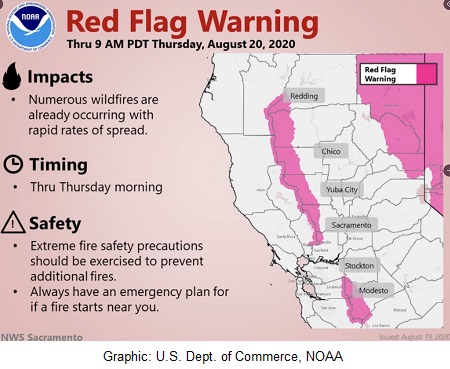During PG&E’s fire-prevention blackouts last October, over one million people in Northern California lost cell service and access to emergency alerts. Now wildfires have begun again amid a heatwave, wreaking havoc in the Bay Area, taking down power lines and cell towers, reported the San Francisco Chronicle. As of Wednesday, the fires have already caused unplanned power outages amid the scheduled blackouts meant to prevent the spread of the blazes. (See fire locations at Wildfire Today.)
Concerns abound over the loss of power and damage to infrastructure, threatening the ability for the Bay Area’s emergency warning systems to alert residents and for those residents to access critical information online. According to a PG&E outage map, as of Wednesday, over 5,000 residents in and around Vacaville lost power, and more than 4,000 in Santa Cruz and San Mateo counties are in the dark. Also, on Wednesday, Napa County experienced outages affecting 24,000 customers.
According to the Chronicle, the time it takes to restore service after a wildfire can vary depending on the conditions. “We have to wait to gain access to areas impacted by the fire to determine the impact to our facilities. The length of outage usually depends on the extent of damage,” PG&E representative Brandi Merlo told the news outlet.
Rotating outages typically last two to three hours, according to the utility, while unplanned outages are less predictable. Live fires also prevent crews from reaching damaged areas to make repairs, lengthening outage times. If a home loses power, internet routers will go down, causing a loss of WiFi signals. And if cell service is also unavailable, residents may have no way to receive essential alerts and information, reported the Chronicle.
Comcast spokesperson Joan Hammel said backup generators are used to ensure continued internet access during power outages. Still, sustainability is uncertain, depending on the length and size of the outage. “The size and scope of this heatwave is immense,” Hammel said. “There is only so long we can support services on generators.”
Generators and backup batteries can also only go so far when it comes to cell towers as well. The California Public Utilities Commission voted last month to require 72 hours of backup power at cell towers during emergencies, noted the Chronicle. Providers have 11 months left to develop a resiliency plan and implement required updates. Both Verizon and AT&T commented on their dedication to their California customers amid challenges.
“While we are doing everything possible to minimize the impact of power outages, there are discrete areas where we cannot install generators due to topographical or other constraints. In these rare cases, some customers may experience service disruptions or degraded network performance until commercial power is restored,” Heidi Flato, a spokesperson for Verizon, wrote in an email.
“We understand the importance of keeping customers and first responders connected during emergencies, including power shut-offs. That is why we have invested more than $8.7 billion in our California networks from 2017 to 2019, and announced a three-year, $340 million plan to add backup power to more cell sites,” stated Jim Greer, an AT&T spokesperson.





Reader Interactions